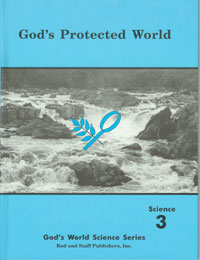See my general review of Rod and Staff curriculum. These courses are all published with hardcover student textbooks.
Patterns of Nature, grade 2
This text leads students through a study of nature with an emphasis on observation and identification. God as Creator is a strong theme.
God's Protected World, grade 3
This text explores materials and their properties; the relationships between the sun, moon, and earth; animal classification; and simple machines. God's care of His creation is emphasized as the general theme. New words are introduced at the beginning of each lesson. Then lessons are divided into two parts: the first is intended for teaching or group work, while children should read the second part on their own. Questions follow the reading assignment. Unit tests are available in a separate booklet.
A teacher's manual is available but should not be necessary. However, the teacher's manual has reduced student pages surrounded by answers, instructional information, teaching suggestions, and activity ideas. The teacher's manual is written with inexperienced teachers in mind, so it's easy to use.
God's Inspiring World, grade 4
In this text, health and safety topics are introduced with units on the eye and on human diseases. Other science topics covered are weather, stars, electricity, light, animals, and plants. The teacher's manual for this text is similar to that for third grade.
God's Wonderful World, grade 5
The scientific method is introduced along with anatomy, arthropods, non-flowering plants, chemistry, sound, machines/motion, and earth science. The teacher's manual for this text is similar to that for third grade.
God's Marvelous Works 1
Books 1 and 2 are targeted for grades five and six, but they work especially well for homeschoolers with children working at different grade levels.
The main topics are insects, birds, flowers, and reptiles, with a strong emphasis on God as Creator. Observation and study are the principal methods of learning.
God's Marvelous Works 2
This text teaches students about algae and fungi, mammals, aquatic creatures, and amphibians. It should follow God's Marvelous Works 1. As with other Rod and Staff science texts, learning is primarily through study and observation rather than experimentation and activities.
Investigating God's Orderly World, Book 1
This is Part One of a basic science course covering life, physical, and earth science topics. Unit topics include astronomy, gravity, heat energy, weather, the planet Earth, life on earth, fire, parasitic diseases, food and digestion, and agriculture. Study and review exercises are included in the student book. Some experiments are described in the text. The teacher's guide suggests teaching methods, lists equipment needed, and serves as an answer key. Test booklets are also available. Like other Rod and Staff science books, it glorifies God as Creator, relating science to Scripture throughout. This text is suitable for grades seven and eight.
Investigating God's Orderly World, Book 2
This is Part Two of a foundational science course. Topics covered include light, sound, the body, behavior, work and machines, energy and engines, principles of chemistry, elements, electricity and magnetism, reproduction and heredity, and care of the body. Study and review exercises are included in the student book. Some experiments are described in the text. The teacher's guide suggests teaching methods, lists equipment needed, and serves as an answer key. Test booklets are also available. This text should be used for eighth grade or else following the first volume, Investigating God's Orderly World, Book 1, to provide comprehensive coverage of science before getting into topical high school courses.










